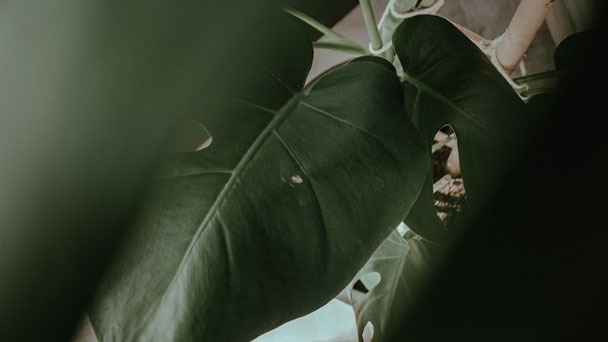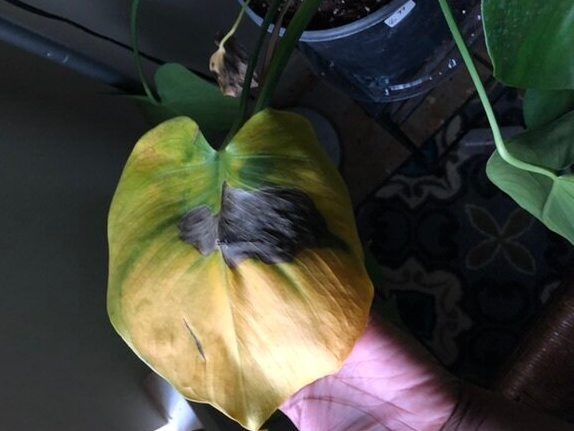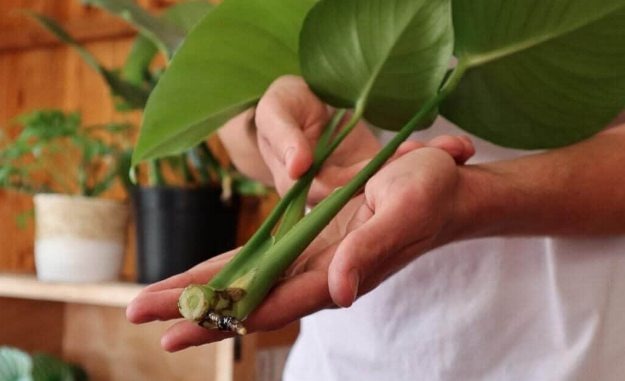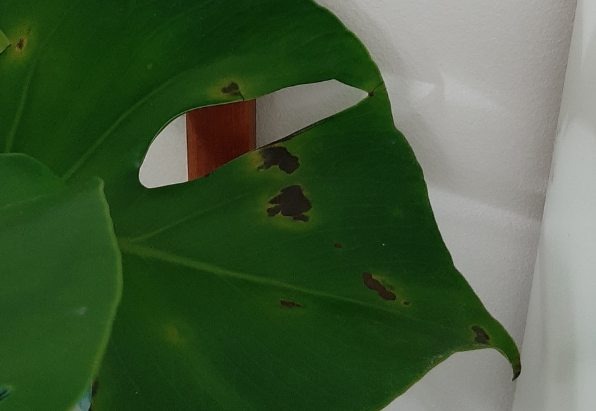Monstera Root Rot - Signs & How to Treat
Written by Ivy
Jan 05 2023

If your Monstera plant's roots are left in stagnant water for an extended period of time, it can develop root rot, which causes them to turn mushy and brown. Since root rot provides the ideal environment for fungus and bacteria to grow, it is essentially a fungal infection that results in rotting roots that affect the entire plant and have an unpleasant smell.
What Causes Root Rot in a Monstera Plant?
- Overwatering. One of the main causes of Monstera root rot is overwatering. you can easily know that you are overwatering when you are watering too frequently, or its not being drained properly. The potting soil's moisture content can always be checked, and you should only water when the soil's top layer is dry.
- Poor drainage. It is crucial to have a pot with a well-draining bottom because water can still accumulate there even with a regular watering schedule. Bacteria and other infections can flourish in the infected roots due to the lack of oxygen.
- Heavy soil. It's also possible that the soil isn't loose enough, which would cause a drainage problem. make sure you have a good potting soil and add something lighter like sand or perlite.
- Oversized pots. Greater pot sizes result in slower soil drying times and slower water evaporation rates. The best is a pot that is precisely the right size for your Monstera and permits proper airflow and soil drying.
- Low temperature. Monstera is a robust plant that isn't greatly impacted by weather, although it can suffer when the temperature falls below 50 degrees Fahrenheit. The probability that the soil will become damp and soggy increases as the temperature drops. The likelihood of the roots becoming infected will rise as a result.
- Not enough sunlight. It is less likely that the soil will dry out if your Monstera doesn't receive enough light. For monsteras to flourish, they require 5-8 hours of direct, bright light each day.
How to Save a Monstera After Root Rot
Most of the time, there is a solution for every problem. By removing the plant's roots and removing it from the contaminated soil when the Monstera is still in the early stages of root rot, you can always save it. In order to know what stage of stem rot the plant is in, you must first evaluate it. If your Monstera deliciosa is severely rotting, you will need to completely repot it and remove all the soil. Unfortunately, it cannot be saved if all the roots are completely mushy and black.
What You'll Need
- Gardening scissors, knife or pruning shears
- A new clean pot
- New potting mix
- White vinegar
- Fungicide
- Bleach or rubbing alcohol for sterilization
- Gloves
What You'll Need to Do
- Disinfect your pot. If you don't intend to move your plant to a new pot, clean the old one with a bleach solution. Remove the plant from the pot gently, then wrap the roots in a plastic bag. Clean the pot with pure water after sterilizing it with a 10% bleach solution.
- All the broken roots should be washed and cut. To treat root rot, you must remove all the damaged roots and infected material. Cut off all of the mushy roots with a sharp knife after sterilizing it.
- Dry and clean the roots. To avoid reinfection, allow the roots to completely dry out in the sun. It might take a couple of hours. After, be sure to fungicide-treat the roots. A diluted hydrogen peroxide solution can also be used.
- Trim away the harmed leaves. By removing and pruning any unhealthy or yellow leaves, you can rid the plant of all the infected stems and leaves.
- Put a fresh pot on your monstera. You can either plant your Monstera in a brand-new pot with brand-new soil and potting mix, or you can use your old pot (after sterilizing it with vinegar first). Make sure your pot has drainage holes, then fill it with potting soil to the top third.
Your plant will grow healthier and more robust every day as it naturally adjusts to its new environment. To stop any future fungal infections, place the plant in indirect bright light.

How to Treat Root Rot in Monsteras
Monsteras are hardy plants, and root rot is easily remedied, so don't be alarmed. Here's what to do:
Repot
Get your monstera out of the muddy, wet soil as soon as possible. You might want a friend to assist you in carefully removing your monstera from the pot so that you can thoroughly rinse the roots of the plant. Carefully prune away any rotting roots you find.
After that, repot the plant in a tidy pot with good drainage and fresh soil. (You can clean the current one or purchase a new one.)
Prune the Affected Leaves
You should take the affected leaves out of the plant to prevent the infection from spreading because root rot is typically a fungal issue. Additionally, this eliminates those unsightly brown spots.
Fortunately, monsteras take pruning well!
Wearing gloves will protect your hands while you prune your monstera. To remove the leaf at the stem, use clean, sharp pruning shears or a sharp knife. To prevent the pathogens from spreading to your other plants, throw the curly leaves in the trash and remove it right away. (Read More: Why My Monstera Leaves Curling)
Put It in Bright, Indirect Sunlight
Reposition your monstera in direct, bright sunlight after repotting and pruning so that it can adjust and recover. Move it closer to a window or add a grow light like this if you believe that the root rot issue was caused by a lack of light, so that it doesn't happen again!
Use Our Root Rot Treatment
After treating your plant for root rot, water it a little less frequently for the first few weeks, but when you do, use our root rot treatment to aid in root healing and stop the rot from coming back!
Because airborne bacteria and fungal spores can cause root rot to spread from one plant to another, it's not a bad idea to apply this treatment to your other plants as well.
Signs of Root Rot Vs. Healthy Roots
Root rot is initially noticeable by the color of the roots. A healthy Monstera root will be white or creamy in color, while a rotted Monstera root will be brown or black. The texture of the root surface is the second clue. The slimy texture associated with root rot will not be present in healthy roots.
Thirdly, you can tell a healthy root from a rotting root by the way it feels when you press on it. The turgid, healthy plant cells that transport water and nutrients to other plant parts will cause the healthy Monstera roots to be firm. Unhealthy, rotting roots will feel squishy and likely burst because the cells are dead or dying.
Finally, healthy roots don't smell bad like rotting ones do.
How to Prevent Monsteras Root Rot
- Proper drainage. This particular point is crucial. make sure your pot has drainage holes, so the roots of your plant have room to breathe. A pot without holes for drainage is strongly discouraged. Get a pot with more drainage holes if there are drainage holes but no water is visible coming out of the bottom.
- Do not reuse soil. You shouldn't leave your Monstera plant in the same infected soil if you have already identified it as having root rot. To avoid reinfection, you can replace the soil in your Monstera plant's pot every year and a half with better soil.
- Before using a pot again, clean it. If you have a fungal issue, you should clean the pots with vinegar or alcohol to get rid of all the bacteria. let it dry in the sun after to make sure all the harmful bacteria is gone. Neem oil can be added to your soil to give it more defense.
- the appropriate soil mixture should be used. A potting mixture with good drainage and moisture retention is preferred by monstera plants. For the soil mixture to be ideal for your Monstera, you can add some organic moss, coco coir, or other organic matter.
- Before watering the soil, allow it to dry out. By examining the first 2 inches of the soil's top layer, you can determine whether your soil is sufficiently dry. Wait a few more days for the soil to dry out if it's still wet and damp before re-watering.

How Do I Know If My Monstera Has Root Rot?
Wilting or yellowing leaves and slow growth are some early warning signs that your Monstera has root rot. Thin, dark, or mushy stems, leaves with black spots, and roots that smell bad, are all signs of more advanced root rot. Checking the roots of your Monstera directly is the best course of action. (Read More: Why Does My Swiss Cheese Plant (Monstera Deliciosa) Have Yellow Leaves?)
As was previously mentioned, it is not easy to tell whether your Monstera has root rot. You won't be able to confirm it by simply looking at the crop in its early stages unless you have a clear view of the roots, which an owner rarely has.
The early signs of Monstera root rot could point to a number of issues with your Monstera, but root rot is the most frequent. When you recognize these symptoms and take the appropriate action to address your Monstera root rot right away, you can save it from destruction.
There is a chance that you can save your Monstera when the more severe symptoms start to show, but it is regrettably not guaranteed. To prevent the infection in the roots spreading to your other houseplants, it's actually frequently preferable to just throw away the plant if it has become too sick.
For more information on what Monstera root rot looks like, continue reading.
1. Wilted Leaves
Wilted leaves are an indication that your Monstera needs more water in the soil. If your Monstera is wilting away, check the soil to see if it is moist or dry. If there isn't enough moisture in the air, your Monstera might simply be thirsty, so it would be best if you gave it a good, hearty drink of water.
Your Monstera's roots have likely been harmed by rot if the ground is already a little moist and the leaves are drooping. As a result, they are unable to absorb previously applied water. You should at this point carefully inspect your Monstera's roots for rot.
2. Stagnant Development
If your Monstera's growth is stagnant, it means that it isn't growing as quickly as it should. This happens frequently during the winter when the days get shorter and the temperatures drop. Monsteras' growth slows down if they don't receive enough light, fertilizer, or moisture.
However, a Monstera's lack of new growth isn't always a sign that its roots are rotting. Less water is needed for a Monstera because its growth is slow and too much moisture during this period can lead to root rot.
3. Yellowing Leaves
Yellow Monstera foliage is frequently brought on by overwatering and root rot. Yellowing leaves are the next stage after dangling leaves if your Monstera is still rooted in wet soil. (Read More: Why Does My Monstera Have Yellow Leaves)
Check the soil and root systems for excess water and rot if the leaves on your Monstera have turned yellow.
4. Foul-smelling Roots
It's most likely your Monstera's roots if you smell the soil of your plant and it smells like something is decaying.
The more infected your Monstera is, the harder it will be to keep it alive at this point. The stronger the odor, the more infected your Monstera is.
5. Leaves With Black Spots
On the foliage of your root rot Monstera, black spots will sometimes be followed by yellowing around the lesion. Black spots are a sign that the fungus has colonized the entire plant.
From the roots to the stem and the leaves, root rot will eventually affect the entire plant. When there are black or brown patches on the leaves, the process is nearing its conclusion.
6. Discoloration of the Roots
Your Monstera's roots should be whitish like those of other plants. As a result of root rot, the rotting roots turn dark or black and become slick and soft. If you dig into the ground or take your Monstera out of its pot to look at the roots, you can see the discoloration.
When treating your Monstera's root rot, you must remove all of the damaged and black roots. The illness will spread if you don't do this.
7. Thinning of the Stems
Your Monstera's fungal disease has most likely advanced to an advanced stage if the twigs and stalks look brown, thin, or odd. The plant might already be irreparably damaged. It's possible that the crop has been stressed for a long time without anyone noticing because of overwatering and overfertilization. (Read More: How to Save My Overwatered Monstera)
Although monsteras require very little maintenance, too much of anything can result in a variety of problems, including root rot.
8. Dark and Mushy Stems
Your Monstera's central stalk will turn black and squishy, just like the roots, when the rot has spread to it. Since the decaying stem cannot supply the foliage with nutrients and water, the Monstera will soon die.
9. All of the Roots Have Died
You shouldn't expect your Monstera to survive if all of its root hairs have perished. All plants must have roots in order to survive. Without roots, your Monstera won't be able to absorb any nutrients or moisture, and it'll probably die of dehydration.
The Monstera root rot is therefore irreparable because of dead roots.

Can Plants Recover from Root Rot?
Root rot can be repaired by plants. To revive it, you must, however, identify the issue quickly and take the appropriate action. Unfortunately, it may be too late to save your plant if the entire root system has turned to mush.
You must take immediate action as soon as you notice or suspect that your Montera plant might have root rot. With the right steps, you can quickly get your Montera back.
The Bottom Line
In order to avoid root rot, it is best to take care of your Monstera plant beforehand. We don't have to wait until we are extremely ill to begin eating well or taking care of ourselves, just like humans.
A final reminder to check the soil frequently to avoid overwatering and to always pay attention to the leaf color. Make sure to provide enough indirect sunlight for your plant. Throughout their growing season, your Monstera leaves should be brisk, lush, shiny, and expanding.
All of this will guarantee that your Monstera deliciosa plant is very content and flourishing, and that you are a content and assured indoor houseplant owner.
Latest Updated
- Benefits of Bugleweed - 7 Science-backed Health Benefits
- Bugleweed Dangers & Side Effects - Is It Poisonous?
- How to Plant Evergreen Trees - What You Should Know
- When to Plant Evergreens - Grow Guide for Evergreen Trees
- 12 Wonderful Evergreen Shrubs for Your Garden
- 12 Popular Evergreen Plants with Pictures for Beginners
- When And How To Prune A Lilac Bush Like a Pro
- How to Grow & Care for Lilac Vine (Hardenbergia Violacea)
- Japanese Lilac Tree (Syringa Reticulata) Care & Propagation Guide
- Shumard Oak Pros and Cons - What to Know
Popular Articles
- Winter maintenance of Antirrhinum Majus
- How to Grow Terminalia Mantaly Tree
- How to Grow and Care for Crossostephium Chinense
- How to grow Antirrhinum Majus in spring
- Peristeria Elata (Dove Orchid) Profile: Info & Care Guide
- Underwatered Snake Plant (Sansevieria Trifasciata) - Signs And How To Fix
- How to Care for Brazilian Jasmine Plant (Mandevilla Sanderi)
- How to Grow & Care for Graptopetalum Purple Delight in Summer
- Rosa Chinensis (China Rose): Plant Growing & Care Tips
- How to Care for Baby Sun Rose (Aptenia Cordifolia)